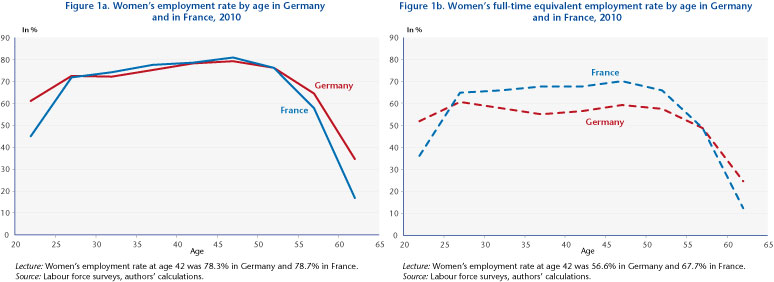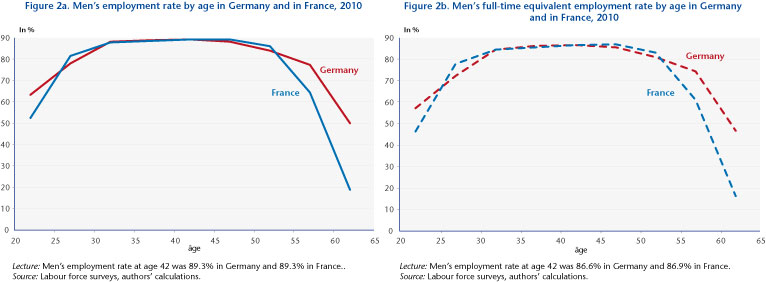By Hélène Périvier and Gregory Verdugo
In terms of the employment rate, French women work less than German women: in 2017 the employment rate of women aged 15 to 64 was 67.2% in France against 75.2% in Germany. But this commonly used indicator does not take into account that to arrange their time German women are more likely to be in part-time work than French women. This is because underemployment and labour market regulations differ in the two countries, in particular as Germany has a plentiful supply of part-time mini-jobs that are held by women more than men. Moreover, the differences in terms of policies affecting the family life-work-life balance in the two countries make it possible to deal with early childhood more extensively in France than in Germany and lead German women to take up part-time work.
To compare the employment situation of women in France and Germany, we use indicators that take into account working time, which we calculate by age to illustrate a life cycle perspective [1]. The results confirm that German women are in part-time work more than their French counterparts, and this is particularly marked at the age of maternity. These differences in women’s working hours explain why the gender pay gap is higher in Germany than in France.
Employment rate and employment rate in full-time equivalents by age
Comparing employment rates with employment rates in full-time equivalents over the life cycle highlights the significant differences between the two countries in terms of the reduction in women’s working hours at the ages when the family constraint is the strongest, between 30 and 40 years old. Figures 1A and 1B show employment rates and full-time equivalent employment rates by age for women in 2010, the moment when European countries were to have reached a female employment rate of 60% according to the Stratégie européenne de l’emploi (EES). Figures 2A and 2B show these same indicators for men.
If we restrict ourselves to employment rates, the models seem similar in the two countries: changes in the employment rates over the life cycle for women are quite similar, as is the case for men (with the exception of the ages of entering and leaving working life, which differ between the two countries for both sexes). In Germany as in France, women’s employment rate is high, but the gap with men increases between age 30 and 40 (solid lines).
Once part-time work is taken into account, the gender division of labour turns out to be much more marked in Germany than in France (dashed lines) [2].
At all ages, the full-time equivalent employment rate for women is lower in Germany than in France (whereas for men it is close to the employment rate, for both countries). From the age of 30, the female full-time equivalent employment rate falls below 60% in Germany, while in France it is above 65%. This means that German women are adjusting their working time more as family constraints become stronger. For men, the full-time equivalent employment rates are close to the employment rates at all ages in both countries.


The overall wage gap: the impact of working time
The massive use of part-time work by women in Germany compared to France explains a large part of the wage differentials, which are higher there. The global wage gap indicator calculated by Eurostat [3] shows that the overall wage gap is very high in Germany (45% compared to 31% in France), and that this is due mainly to differences in working time. On average German women work 122 hours a month against 144 for French women, with the average hourly wage rate being comparable (Table).
 Thus policies aimed at occupational equality cannot leave aside the issue of working time and the quality of the jobs held by women. It seems that from this point of view France is doing better than Germany, although much remains to be done in this area.
Thus policies aimed at occupational equality cannot leave aside the issue of working time and the quality of the jobs held by women. It seems that from this point of view France is doing better than Germany, although much remains to be done in this area.
[1] This blog is taken from: « La stratégie de l’Union européenne pour promouvoir l’égalité professionnelle est-elle efficace ? », [Is the European Union’s strategy for promoting occupational equality effective?], Périvier H. and G. Verdugo, Revue de l’OFCE, no. 158, 2018.
[2] Full-time equivalent employment rates were calculated from the European Labour Force Surveys. Each job is weighted by the number of hours worked. A full-time job is defined as a job where the number of hours worked is greater than or equal to 35. If the number of hours worked is between 25 and 34, we assign a weight of 75% of a full-time job, a weight of 50% if the number of hours is between 15 and 24, and a weight of 25% if the number of hours is less than 14 hours.
[3] The gap calculated by Eurostat corresponds to the average wage differential for the entire population.
Leave a Reply